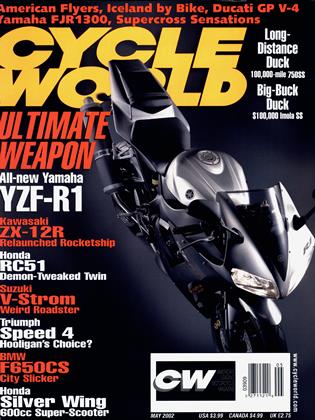$100,000 Ducati
History for sale
The Scene: Sotheby’s Auction for Motorcycles and Bicycles, Chicago, Illinois, September 15, 2001.
The Subject: Lot 350, a 1972 Ducati 750cc Desmodromic Road Racer, Serial Number 750-397, ridden by Bruno Spaggiari on April 23, 1972, at the inaugural Imola 200, “The Daytona of Europe.” There, the Italian rider finished a desperate breath behind winner Paul Smart on a similar Ducati racebike.
The Shock: When the auction hammer fell, Lot 350 had sold for $121,250, including the buyer’s premium. For an old racebike that finished second-well, why so much?
The Answer: History.
Without that Smart-Spaggiari 1-2 victory at the highestprofile European race in 1972, everything would have been different for Ducati. There would have been no rebirth of the desmodromic legend, no 750cc V-Twin bevel-drive desmo, no aura and luster to the Ducati name. Ducati would likely have faded away slowly, remembered for its brilliant bikes of the Fifties and, in its declining years, for its wonderful spring-valve, bevel-drive V-Twin GT-750. Even with the incandescent glow from its 1972 Imola triumph and subsequent desmo sportbikes, Ducati barely weathered the Seventies and Eighties. The total production of all Ducati bevel-drive Twins amounted to a mere 30,000 units. So Imola ’72 provided the razor-thin margin for survival.
Although the Imola organizers sculpted the rules to favor big production-based four-stroke 750s (by excluding twostrokes under 500cc), Ducati still looked like a bench player behind the Triumph/BSA Triples and Giacomo Agostini’s
works MV Agusta 750. Insiders thought desmodromic valve actuation was a quaint and arcane technology even in Ducati's updated and simplified form of the late Sixties.
At least Ducati did have two excellent riders. Englishman Paul Smart, induced by Ducati money at the last minute, was widely recognized as one of the three or four best riders in the world. Veteran Bruno Spaggiari, 39 years old, ran for Ducati in the Fifties, Sixties and Seventies. What Ducati had built, Spaggiari had raced. And he knew Imola as intimately as he knew the Bologna V-Twin.
On race day, Smart and Spaggiari soon cleared off, leaving early leader Agostini trailing in third place, 10 seconds back. The upfront Desmos were astonishingly fast; the two other team bikes, ridden by Italian Ermanno Guiliano and Brit Alan Dunscombe, languished downfield, seemingly products of a lesser God. Smart and Spaggiari, circulating together out front, conserved their bikes and postponed the real accounting until the final 15 miles. Then the race for the richest purse in European roadracing was on. Spaggiari nipped into the lead, but Smart hung on, figuring to pass on the last lap. A mile-and-a-half from the checkered flag, Spaggiari went wide in a fast sweeper-almost running off the road-when his bike started misfiring as it ran low on fuel. Smart dove to the inside and went by. He won, but Spaggiari’s ride made it a victory worth remembering.
Immediately after the race, Fredmano Spairani, Ducati’s corporate boss, gave Smart his winning bike, and then in a flourish announced that Ducati would build “road-going replicas” of the desmo racers. This was the origin of the 1973/74 desmo Ducati 750 Super Sport. Finally,
Spairani sold the Spaggiari racer to Ron Angel, the Ducati distributor in Victoria,
Australia.
In Australia, the Spaggiari bike lacked its Imola potency. The 750 probably never left Italy with exactly the same parts (gearbox and camshafts, for starters) it had on Imola raceday. Angel and his rider,
Kenny Blake, campaigned the machine for a year or so before setting it aside. After spending
many years in Australia, the Ducati went to England, where collector Valentine Lindsay added the bike to his stable.
The issue of internal parts notwithstanding, serial number 397 is Spaggiari’s 1972 Imola racer, and the bike has a clear, unbroken and undisputed chain of custody. At the most, there were just eight of these bikes built; the most significant two are the Smart and Spaggiari bikes. Paul Smart still has his machine, and it’s not for sale. Thus, the choice confronting a potential buyer was the Spaggiari racer or nothing at all.
In many cases, very special motorcycles trade privately, and the Spaggiari bike was so offered for some time before consignment to Sotheby’s. The auction house’s dazzling and sumptuous catalogue reaches a wide audience, and sometimes presentation is everything. Often, an auction environment assures an individual bidder that he is not alone in his personal estimate of the worth or value of an object.
or value of an object. How one values history will always be an intensely per sonal matter. Consequently, auctions have surprising twists. The top-selling lot at Sotheby's was an original, unrestored 1914 Sears motorcycle. It cashed out for $126,750, includ ing buyer's premium. So, at the race in Chicago, this time measured in dollars, the Spaggiari bike finished second again.
Phil Schilling
 View Full Issue
View Full Issue
More From This Issue
-
 Up Front
Up FrontMad Max Found!
May 2002 By David Edwards -
 Leanings
LeaningsA Trip To the Barber
May 2002 By Peter Egan -
 TDC
TDCRoom At the Top
May 2002 By Kevin Cameron -
 Departments
DepartmentsHotshots
May 2002 -
 Roundup
RoundupBeyond the V-Rod: Harley's Next Revolution?
May 2002 By Steve Anderson -
 Roundup
RoundupDesmosedici!
May 2002 By Brian Catterson








